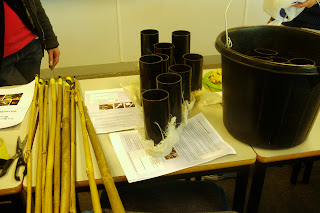We used the bait tube method of surveying, which involved laying out 10 baited tubes in a 100m transect.
Our tubes (cut up drain pipe) were sealed at one end with muslin and an elastic band, before being baited with some small chunks of apple, and casters (blowfly pupae).
 |
| Our equipment |
The setting out of the transects was more difficult than it sounds, as we were battling our way through the woodland undergrowth which in parts consists of bramble, holly and lots of other spiky plants!
 |
| Blowfly pupae - delicious if you're a vole! |
We covered our tubes well with a layer of leaves, and left them for a week...
Exactly one week later we returned... surprisingly we found all 10 of the tubes again. A quick poke around in the tubes with a spatula revealed what we were looking for... small mammal poo!
We scraped out the contents and put them in a sealed bag which was then sent to a lab. They analyse the DNA to determine which small mammals visited our tubes!
The data is really important to the Mammal Society who are mapping the distribution of small mammals in the British Isles, and want to record long term data for future analysis. The data is useful to us as it gives us a really good indication of what lives in our woodland, and therefore how healthy it might be. This will influence our woodland management and biodiversity action plan!
Thank you to all the volunteers who helped out on the two days, and to Laura who took the photographs. Laura is undertaking this same surveying technique at Tolworth Court as part of her biology dissertation and we wish her good luck!



No comments:
Post a Comment